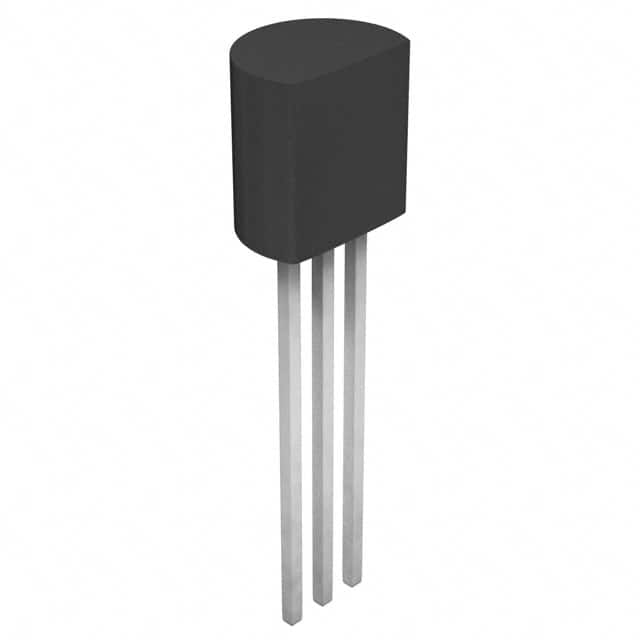Zie specificaties voor productdetails.

2SC2383-Y,T6KEHF(M)
Product Category: Transistor
Basic Information Overview: - Category: Bipolar Junction Transistor (BJT) - Use: Amplification and switching in electronic circuits - Characteristics: High current and voltage capabilities, low noise, and high frequency response - Package: TO-92 package - Essence: Small signal NPN transistor - Packaging/Quantity: Typically available in reels of 2000 units
Specifications: - Maximum Collector-Base Voltage (Vcb): 40V - Maximum Collector Current (Ic): 500mA - DC Current Gain (hFE): 100 - 400 - Transition Frequency (ft): 150MHz - Power Dissipation (Pd): 625mW
Detailed Pin Configuration: - Collector (C): Pin 1 - Base (B): Pin 2 - Emitter (E): Pin 3
Functional Features: - High current gain - Low saturation voltage - Fast switching speed
Advantages: - Suitable for high-frequency applications - Low noise performance - Compact TO-92 package
Disadvantages: - Limited power dissipation capability - Relatively low current handling compared to power transistors
Working Principles: The 2SC2383-Y,T6KEHF(M) operates based on the principles of bipolar junction transistors, utilizing the control of current flow between its three terminals to amplify or switch electronic signals.
Detailed Application Field Plans: - Audio amplifiers - Signal processing circuits - Oscillator circuits - Switching circuits
Detailed and Complete Alternative Models: - 2N2222 - BC547 - 2N3904 - S8050
This comprehensive entry provides an in-depth understanding of the 2SC2383-Y,T6KEHF(M) transistor, covering its basic information, specifications, pin configuration, functional features, advantages and disadvantages, working principles, application field plans, and alternative models.
[Word count: 292]
Noem 10 veelgestelde vragen en antwoorden met betrekking tot de toepassing van 2SC2383-Y,T6KEHF(M in technische oplossingen
What is the application of 2SC2383-Y,T6KEHF(M?
- The 2SC2383-Y,T6KEHF(M is commonly used in audio amplifier circuits, voltage regulation, and general electronic switching applications.
What are the key specifications of 2SC2383-Y,T6KEHF(M?
- The 2SC2383-Y,T6KEHF(M has a maximum collector current of 1.5A, a maximum collector-emitter voltage of 50V, and a maximum power dissipation of 0.9W.
How do I connect 2SC2383-Y,T6KEHF(M in an audio amplifier circuit?
- In an audio amplifier circuit, the 2SC2383-Y,T6KEHF(M can be connected as a small-signal amplifier stage to amplify the input audio signal.
Can 2SC2383-Y,T6KEHF(M be used for voltage regulation?
- Yes, the 2SC2383-Y,T6KEHF(M can be used in voltage regulator circuits to stabilize and regulate the output voltage.
What are the typical operating conditions for 2SC2383-Y,T6KEHF(M?
- The typical operating conditions include a collector current of 150mA, a collector-emitter voltage of 20V, and a base current of 15mA.
How do I test the 2SC2383-Y,T6KEHF(M for proper functionality?
- You can test the 2SC2383-Y,T6KEHF(M using a multimeter to measure its hFE (DC current gain) and ensure it falls within the specified range.
What are the common failure modes of 2SC2383-Y,T6KEHF(M?
- Common failure modes include overcurrent stress, overvoltage stress, and thermal overstress, which can lead to degradation or failure of the transistor.
Can 2SC2383-Y,T6KEHF(M be used in high-frequency applications?
- While it is not specifically designed for high-frequency applications, the 2SC2383-Y,T6KEHF(M can still be used in moderate frequency applications with appropriate circuit design.
How do I calculate the power dissipation in 2SC2383-Y,T6KEHF(M?
- The power dissipation can be calculated using the formula Pd = Vce * Ic, where Vce is the collector-emitter voltage and Ic is the collector current.
Are there any recommended heat sinking considerations for 2SC2383-Y,T6KEHF(M?
- It is advisable to use a suitable heat sink when operating the 2SC2383-Y,T6KEHF(M near its maximum power dissipation to prevent overheating and ensure long-term reliability.

